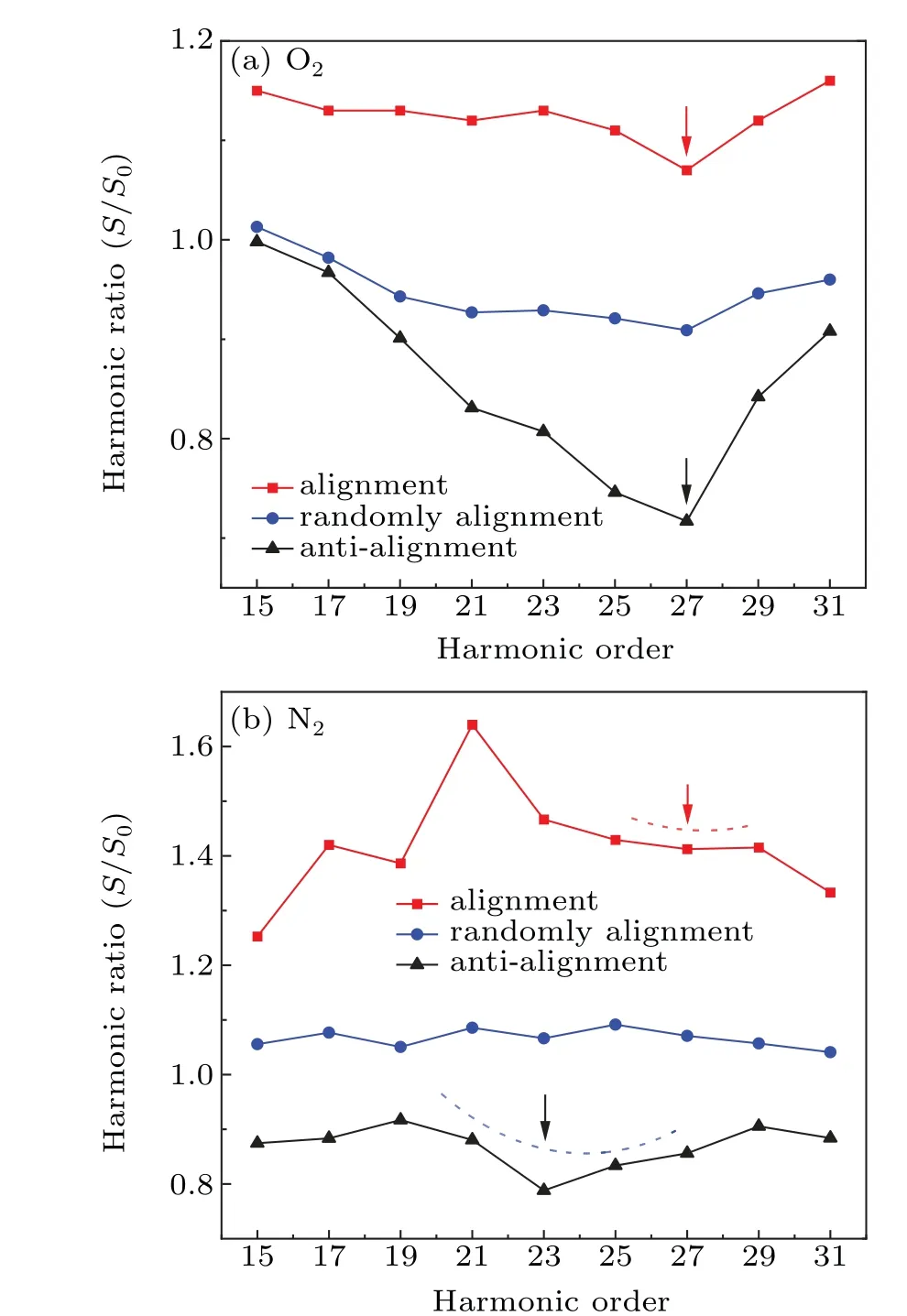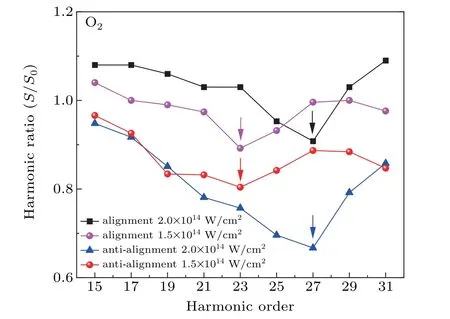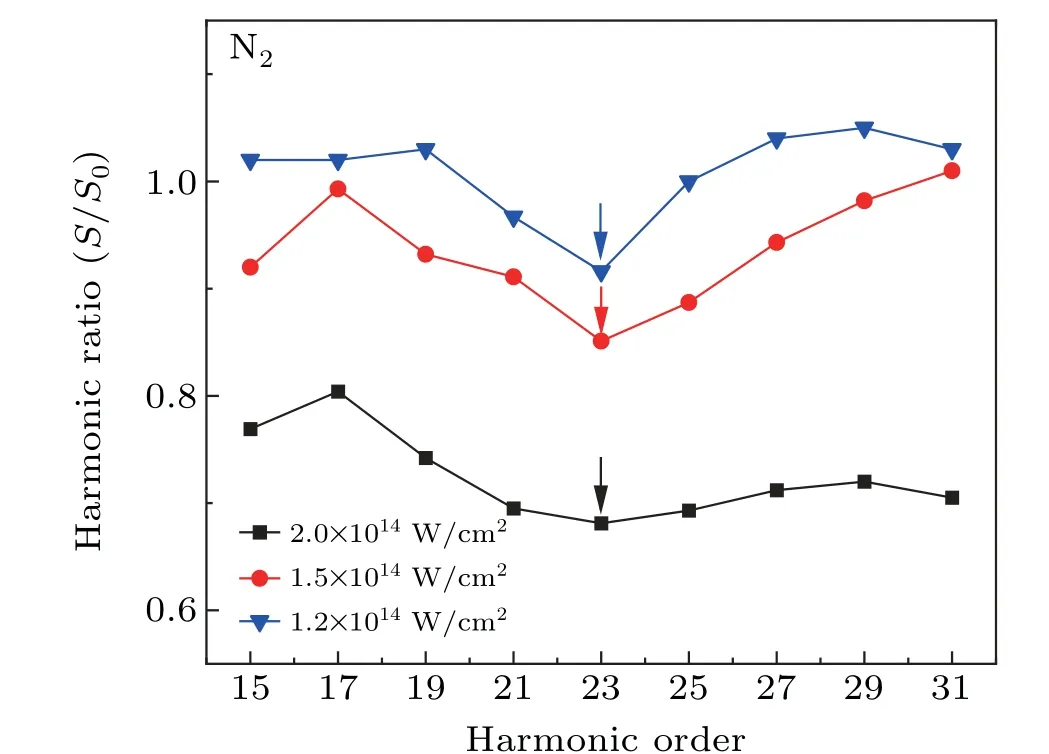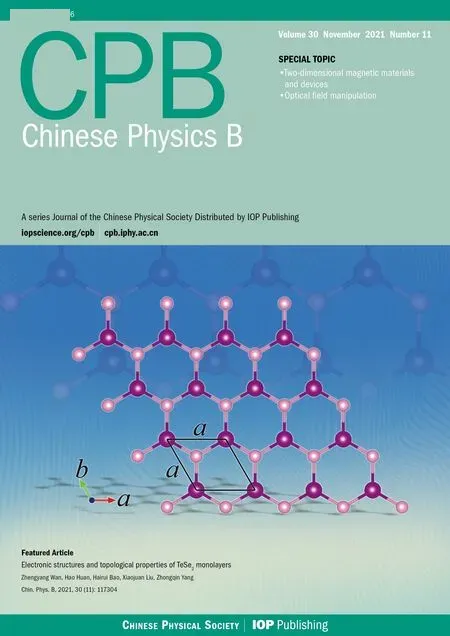Minimum structure of high-harmonic spectra from aligned O2 and N2 molecules*
Bo Yan(闫博) Yi-Chen Wang(王一琛) Qing-Hua Gao(高庆华) Fang-Jing Cheng(程方晶)Qiu-Shuang Jing(景秋霜) Hong-Jing Liang(梁红静) and Ri Ma(马日)
1Institute of Atomic and Molecular Physics,Jilin University,Changchun 130012,China
2College of Science,Jilin Institute of Chemical Technology,Jilin 132022,China
Keywords: high-order harmonic generation, aligned molecule, multi-orbital interference of molecules,Cooper-like minimum
1. Introduction
High-order harmonic generation from gases subjected to intense laser field is the unique technology to obtain attosecond pulses and desktop extreme ultraviolet (XUV) coherent light sources,[1-5]which provides a promising approach to the study of strong field physics.[6-9]Information extracted from HHG spectrum can be obtained to assist in resolving physical processes involved in ultrafast electronic dynamics and reveal the different orbital contributions in molecular harmonic emission.[10,11]The de-Broglie wavelength of electrons, recombined with the parent ion, determines the spatial resolution of harmonics at the ˚A scale.[12]And the time of reversing determines the attosecond temporal resolution of harmonics.[13-15]Therefore,HHG is remarkably important to investigate molecular orbital structure and conduct ultrafast imaging.[16]HHG emission can be well described by a threestep model.[17]In the semi-classical model, an electron in an atom or molecule is tunnel-ionized by an intense laser field,entering a free continuum state(the first step). After that,it is accelerated in the electric field(the second step),returning to the parent ionic core at a certain probability and emitting highenergy photons (the third step). Since electron-ion recombination plays a decisive role in harmonic emission,substantial information related to molecular structure and orbitals can be extracted from the HHG spectrum.[9,18,19]Many investigations have identified that structure and phase of the rotating wave packet,as well as the molecular orbital structure,are encoded in the HHG spectrum.[20,21]
HHG from atoms has been extensively studied due to the fact that atoms are centrally symmetric, whose harmonic spectral properties are simple to be understood. Compared with atoms, molecules contain more information, including complex orbital structure, various rotational and vibrational states,etc., which have attracted wide attention in the study of HHG spectrum.[21,22]Since the distribution of molecules in space is random and isotropic, it is difficult to investigate the harmonic characteristics in various rotational states. However, the technique of molecular alignment and orientation provides a feasible approach for such studies.[23-27]Molecular harmonics are normally understood from the contribution of highest occupied molecular orbital (HOMO). In recently years, extensive experimental measurements and theoretical calculations have demonstrated that molecular HHG can be generated not only from their HOMOs, but also from lowerlying molecular orbitals(HOMO-1,HOMO-2,...).[28-30]For example, Smirnovaet al. have reported that the harmonic spectrum of CO2molecule involves a minimum structure,which was caused by the multi-channel interference in the high-harmonic emission.[28]Yunet al. investigated the contributions of HOMO and HOMO-1 on HHG from aligned CO2molecules by using an orthogonally polarized two-color laser field.[29]Very recently, Luppiet al. performed a theoretical study on the harmonic spectra of uracil and thymine molecules,the results of which indicated that the HHG signal for both molecules possibly originates from different ionization channels.[30]
Properties of the minima in molecular harmonic spectra have been extensively reported in the literature, and three kinds of physical mechanisms can be attributed to the minima in the harmonic spectra. Among them,the minimum induced by two-center interference will change significantly with the alignment angle of molecules.[9,31]The harmonic order of the minimum caused by dynamic interference also varies with the driver laser parameters.[21,28]Alternatively,the position of the Cooper-like minimum is independent of the driving laser parameters and molecular alignment angles.[32-34]Understanding the mechanism of the minima in HHG can reveal the characteristics of the harmonic spectra intuitively,enabling further knowledge about the physics in strong laser fields.
In this work, we experimentally measured the harmonic spectra of aligned O2and N2molecules under a linearly polarized laser field. The harmonic yield is investigated for different laser intensity and molecular alignment angle.Based on our experimental observations,we discuss the multi-orbital interference minimum and Cooper-like minimum on HHG from aligned O2and N2in strong laser fields.
2. Experiments
The experimental setup to generate harmonics has been described in our previous works.[21,35]We used a 1-kHz Ti:sapphire laser system,providing 6-mJ 35-fs pulses at 800 nm.The output laser pulse was divided into two parts. One laser beam with lower energy(the aligning pulse)was used to create rotational wave packets and induce nonadiabatic alignment of O2and N2molecules,while the other beam with higher energy (the driving pulse) was used to drive molecules to generate harmonics. The combination of a half-wave plate and a Glan laser polarizer was placed on each branch of the light path to precisely control the laser energy. In addition,a motorized delay stage with ultra-high precision was set into the path of the driving beam to control the relative delay time between the two beams. After focused by a lens with a focal length of 500 mm,the aligning and driving beams were collinearly sent into the gas zone. The O2and N2gases were introduced into the chamber through a diffuse nozzle(100-µm diameter)with a backing pressure of 2 bar(1 bar=105Pa)and the rotational temperature was about 100 K.Harmonics were dispersed by a spherical grating with a groove density of 1200 grooves/mm,and photonic signals were amplified by a microchannel plate detector and imaged into a phosphor screen, which were received by a CCD camera to perform spectral imaging.
3. Results and discussion
In this study, we investigate the harmonics from aligned molecules by changing the molecular alignment angle and the intensity of the driving laser, so as to learn more about the molecular orbital effect on the strong-field HHG.We first focused on molecular alignment by measuring the harmonic intensities on various delay times between the aligning and driving pulses. The polarization directions of the lasers were set to be parallel. The results of the 19th order harmonic(defined as H19)for O2and N2molecules are shown in Figs.1(a)and 1(b),respectively. The laser intensities of the aligning and the driving pulses are 7.0×1013W/cm2and 2.0×1014W/cm2,respectively. The aligning pulse duration (35 fs) used in the experiments is much shorter than the rotational periods of the molecules (Trot= 11.6 ps of O2andTrot= 8.3 ps of N2),which makes the rotational wave packet excited and induces the nonadiabatic field-free alignment of molecules.[24-26]The effect of such nonadiabatic impulsive alignment on molecules was reflected in the modulation of harmonic intensity, as described in Fig.1.To reduce the effect of instrumental response for qualitative comparison,we adopted the ratioS/S0(normalized harmonic intensity from aligned molecules (S) to nonaligned ones(S0)). In Fig.1(a),the obvious modulation of the harmonic intensity of O2molecules occurs at the delay time of~5.8 ps and~11.6 ps, which refer toTrot/2(half rotational revival time)andTrot(full rotational revival time),respectively.In Fig.1(b),similar modulation on N2molecules occurs at the delay time of~4.1 ps and~8.3 ps.

Fig. 1. Ratio of the H19 intensity between aligned (S) and unaligned (S0)samples of O2 (a) and N2 (b) as a function of the delay time between the two laser beams. The polarization direction of the driving laser was set as parallel to that of the aligning laser and the driving laser intensity was about 2.0×1014 W/cm2.
For further investigation of the alignment dependence of harmonic emission, we measured the intensity of each order harmonic at the alignment, anti-alignment and random alignment for O2(Fig.2(a))and N2(Fig.2(b)).For the O2case,the delay times were set at 5.8 ps, 6.2 ps, and 7.0 ps (red arrows in Fig. 1(a)), corresponding to the molecules mostly aligned along the laser polarization (alignment), perpendicular to the laser polarization(anti-alignment)and random alignment,respectively. While for N2, the delay times were set at 4.1 ps,4.4 ps,and 5.1 ps(red arrows in Fig.1(b))for alignment,antialignment and random alignment, respectively. The study of the harmonic spectrum of aligned molecules provides a powerful tool for understanding molecular structure in intense fields.As shown in Fig.2,an obvious minimum structure in the harmonic spectra for both molecules is observed when the delay time is fixed at the alignment and anti-alignment points,while the randomly aligned molecules have a weaker minimum structure.In the following,we will analyze the harmonic spectral minima of O2and N2molecules in detail.

Fig. 2. Harmonic ratio S/S0 for (a) O2 and (b) N2 molecules as a function of harmonic order at three pump-probe delay times: (a)5.8 ps(red squares),6.2 ps (black triangles), and 7.0 ps (blue circles); (b) 4.1 ps (red squares),4.4 ps(black triangles),and 5.1 ps(blue circles). The driving laser intensity is 2.0×1014 W/cm2. The red and blue dashed curves roughly indicate the position and width of the minimum at alignment point and anti-alignment point,respectively. Arrows indicate the positions of minima.
Smirnovaet al. have discussed the dynamic interference of multiple orbitals from aligned CO2molecules, in which they concluded that the position of the harmonic spectral minimum changes with the laser intensity.[28]Similarly,we measured the intensity of each order harmonic from aligned and anti-aligned O2molecules (Fig. 3) for the driving laser intensity of 1.5×1014W/cm2and 2.0×1014W/cm2. The minimum in the spectrum of either aligned or anti-aligned O2shifts to lower order harmonics as the laser intensity is decreased,i.e., from H27 at 2.0×1014W/cm2to H23 at 1.5×1014W/cm2. Another characteristic is that the position of the minimum remained unchanged with the molecular alignment angle(alignment vs anti-alignment)at the same laser intensity,which is inconsistent with the two-center interference model.
The fact that the position of the minimum strongly depends on the driving laser intensity but is insensitive to the molecular alignment angle indicates the multi-orbital interference effect in HHG of O2.[28]Aside from the HOMO orbital,other lower-lying molecular orbitals also play a role in contributing to the harmonics of O2. Previous studies have shown that the suppression of harmonic yield of O2molecule by multi-orbital interference effect occurs at the plateau region of harmonic spectrum.[36]When electrons are ionized from different molecular orbitals, the subsequent coherent sum of the emissions from multiple channels would bring a minimum in the harmonic spectrum,as shown in the present study. The results would further promote the experimental and theoretical research on HHG of O2molecules under an ultrafast strong laser field.

Fig. 3. Harmonic ratios S/S0 of O2 molecule at the alignment and antialignment points for the driving laser intensities of 1.5×1014 W/cm2 and 2.0×1014 W/cm2. Arrows indicate the positions of minima.
We also investigated the harmonic spectrum of aligned N2molecules in the linearly polarized laser field. As shown in Fig. 2(b), the minimum structure appears at H27 at the alignment point and shifts slightly to the H23 at the antialignment point. In addition, the region of minimum becomes wider and deeper with the increase of molecular alignment angle. The experiment results of N2are similar to those of Farrellet al.[37]For different molecular alignment angles,the contribution of HOMO and HOMO-1 orbitals will change significantly.[10,37]When the molecular axis was parallel to the laser polarization direction,the HOMO orbital of N2molecules mostly contributed to the harmonic yield.While for the molecular axis aligned perpendicularly to the laser polarization (anti-alignment), the contribution of HOMO-1 to the HHG yield increases significantly. The total contribution of HOMO and HOMO-1 at the anti-alignment point makes the intensity distribution of the harmonic spectrum uneven,resulting in the shift of the position of the minimum comparing to that in the case of alignment. For further exploring the HHG spectral minimum in N2molecules, we also gave the dependence of the harmonic spectrum on the driving laser intensity. Figure 4 shows the measured harmonic intensity of N2molecules as a function of the harmonic order by changing the driving laser intensity in the range of 1.2×1014W/cm2to 2.0×1014W/cm2at the anti-alignment case. We notice that the minimum at H23 is rather independent of the laser intensity. These two observations indicate that the minimum structure cannot be simply described by either the two-center interference or the multi-orbital interference effect. Just as Bertrandet al.results,[38]the minimum structure in the N2harmonic spectrum can be attributed to the destructive interference of the p and f partial waves during recombination,and such structure patterns are defined as Cooper-like minimum. Previous analyses have suggested that the Cooperlike minimum is independent of the driver laser parameters(e.g.wavelength,intensity),but only related to the electronic structure.[32-34,38]Experiments on HHG of aligned O2and N2molecules with finely adjusted molecular alignment angle and driving laser intensity may lead to a more comprehensive understanding of the structural characteristics of molecules in the strong laser field.

Fig. 4. Harmonic ratios S/S0 of N2 molecules at the anti-alignment point with different driving laser intensities(2.0,1.5,1.2)×1014 W/cm2, respectively. Arrows indicate the positions of minima.
4. Conclusion
In this work, we have performed an experimental investigation on the harmonic spectra from aligned O2and N2molecules by adjusting the driving laser intensity and molecular alignment angle. The position of the minimum in the HHG from aligned O2molecule shifted obviously by changing the driving laser intensity,indicating the multi-orbital interference effect. On the other hand,the minimum in the harmonic spectrum of aligned N2molecule remained rather unchanged under different laser intensities and only related to the molecular electronic structure,which was interpreted as the Cooper-like minimum. In addition,we also observed the role of HOMO-1 orbital in the minimum of harmonic spectral of N2molecule.These investigations will be helpful for further studies about the interaction mechanism between molecules and strong laser field,and would assist in revealing the features about molecular orbitals and electronic structure.
- Chinese Physics B的其它文章
- Erratum to“Floquet bands and photon-induced topological edge states of graphene nanoribbons”
- Viewing the noise propagation mechanism in a unidirectional transition cascade from the perspective of stability*
- Nonlinear signal transduction network with multistate*
- Optical strong coupling in hybrid metal-graphene metamaterial for terahertz sensing*
- Any-polar resistive switching behavior in Ti-intercalated Pt/Ti/HfO2/Ti/Pt device*
- Magnetic two-dimensional van der Waals materials for spintronic devices*

